As an Amazon Associate KitchenwareSets.com earns from qualifying purchases.
Small Farmhouse Kitchen 9 Simple Ideas For Style And Storage
Struggling with a small kitchen? It can feel like your dream of a cozy, rustic farmhouse kitchen is just out of reach. You see beautiful, sprawling country kitchens on Pinterest and wonder how you could ever capture that charm in a space that feels cramped and limited.
The biggest challenge is balancing that layered, collected-over-time farmhouse aesthetic with the need for clean, functional space. It’s a style known for its character-filled accessories and sturdy furniture, which can quickly turn a tiny kitchen into a cluttered, overwhelming mess. How do you add warmth and personality without sacrificing precious counter space?
A small farmhouse kitchen balances rustic charm with smart, space-saving solutions. The key is using light color palettes, vertical storage, and multi-functional elements to create an open, airy feel while maximizing organization and maintaining that cozy aesthetic. We’ve spent years helping homeowners tackle this exact challenge, and we’ve learned that the right strategies can transform even the tiniest kitchen into a charming farmhouse hub.
Struggling with a Small Kitchen? Here’s How to Get the Farmhouse Look Without the Clutter
The secret to a successful small farmhouse kitchen is marrying the cozy, rustic aesthetic with intelligent, space-maximizing design. It’s not about shrinking down a large country kitchen; it’s about selectively choosing elements that create an open, airy feel while packing in personality and function. You achieve this by focusing on a light color palette to reflect light, using vertical space to draw the eye upward and clear countertops, and incorporating multi-functional pieces that work harder for you. This approach ensures your kitchen feels both charming and efficient, not cramped.
We’ve spent years helping homeowners tackle this exact challenge, and we’ve learned that the right strategies can transform even the tiniest kitchen into a charming farmhouse hub. These nine simple, budget-friendly ideas are specifically designed to maximize both style and storage in compact kitchens.
9 Simple Ideas For Instant Farmhouse Style And Storage
Ready to transform your tiny kitchen into a charming and functional farmhouse haven? This guide is packed with nine high-impact, practical ideas curated for small spaces. Each tip blends timeless design principles with real-world application, giving you actionable steps to create the kitchen you’ve been dreaming of, no matter the square footage. From clever storage tipss to simple decorative touches, these ideas are your roadmap to a beautiful and efficient small farmhouse kitchen. Each of these nine ideas has been curated for its high impact and feasibility in small spaces, blending timeless design principles with practical, real-world application.
1. Embrace Light Colors and Natural Materials
The best way to make a small kitchen feel larger is by using a light, neutral color palette combined with the warmth of natural materials. Walls and cabinets painted in warm whites, creams, or soft grays reflect both natural and artificial light, creating an illusion of spaciousness. Pairing this bright base with natural wood elements like butcher block countertops or reclaimed wood accents introduces the rustic texture and character essential to the farmhouse style.
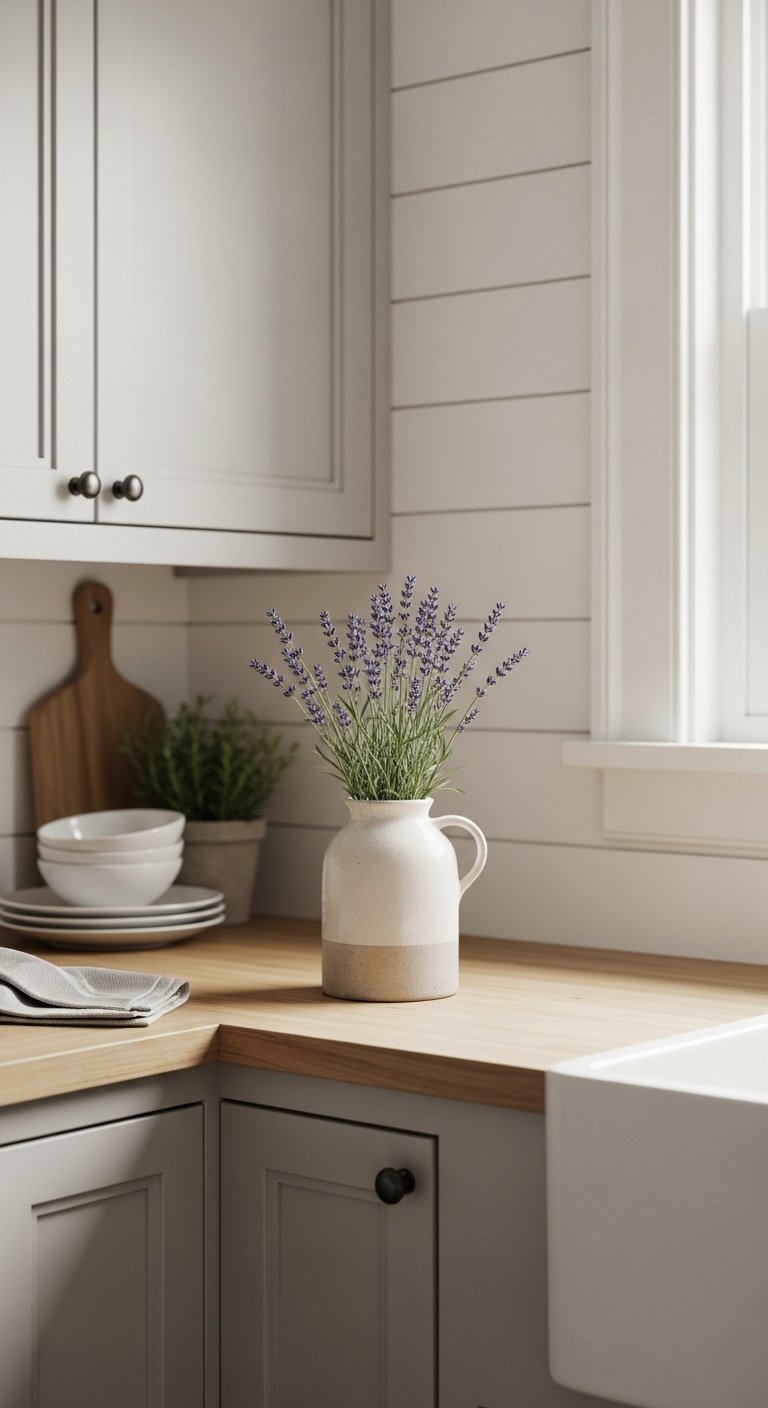
- Materials Needed: High-quality interior paint (in warm white or soft gray), paint rollers, brushes, painter’s tape, drop cloths, wood cleaner/conditioner (for countertops/beams).
- Step-by-Step Directions:
- Prep Your Space: Thoroughly clean all walls and cabinets. Use painter’s tape to protect trim, countertops, and floors.
- Apply a Light Base: Paint walls and cabinetry in a light, neutral color like warm white or cream to reflect light and create an airy feel. Apply two coats for even coverage.
- Introduce Wood Tones: If possible, install or treat a butcher block countertop. Alternatively, add warmth with wooden cutting boards, utensil holders, or a small stool.
- Add Natural Texture: Consider a simple stone or ceramic tile backsplash to add texture and rustic charm.
Pro-Tip: Before committing to a white paint, get samples of 3-4 different warm whites. Paint a small patch of each on your wall to see how they look in your kitchen’s specific natural and artificial lighting throughout the day.
Pin this color palette inspiration for your dream kitchen!
2. Utilize Open Shelving
To make a small kitchen feel more open, replace some upper cabinets with rustic open shelving. This design choice eliminates the visual bulk of cabinet doors, creating an airy, less top-heavy look. It’s the perfect way to display your most-used and beautiful dishware, like white ceramic plates and clear glassware, turning everyday items into functional decor while keeping them easily accessible.
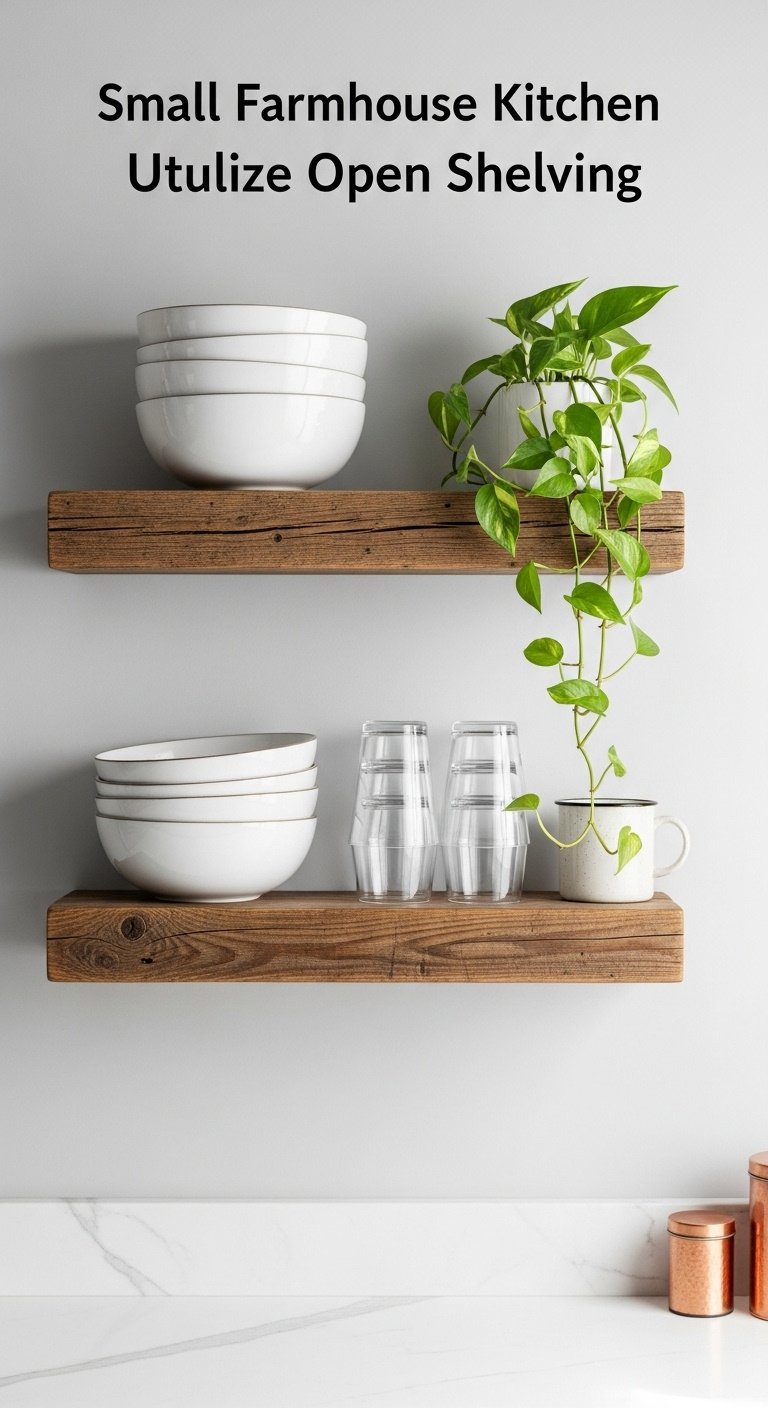
- Materials Needed: Reclaimed wood planks or thick pine boards, heavy-duty shelf brackets, a drill, a level, wall anchors, measuring tape, sandpaper, wood stain or paint.
- Step-by-Step Directions:
- Prepare the Shelves: Cut your wood planks to the desired length. Sand them smooth and apply your chosen stain or paint, allowing them to dry completely.
- Mark Your Placement: Use a measuring tape and level to mark where your brackets will go. Ensure they are level and spaced appropriately to support the weight.
- Install Brackets: Drill pilot holes and secure the brackets to the wall using wall anchors for stability, especially if not drilling into studs.
- Style Your Shelves: Place your most-used and most attractive items on the shelves. Stack plates and bowls, line up glasses, and add a small plant or cookbook for a decorative touch.
Pro-Tip: To prevent a messy look, stick to a cohesive color scheme for your displayed items. All-white dishes, clear glassware, and one or two accent colors (like green from plants or blue from a vintage crock) look curated and intentional.
Love this look? Save it to your ‘Kitchen Storage Ideas’ board on Pinterest!
3. Incorporate a Statement Farmhouse Sink
A compact apron-front sink is the quintessential focal point of a farmhouse kitchen, even in a small one. Opting for a deep, single-basin model around 24 inches wide maximizes functionality for washing large pots and pans without overpowering the space. Its exposed front adds immediate, authentic character and serves as a beautiful anchor for the entire kitchen’s design.
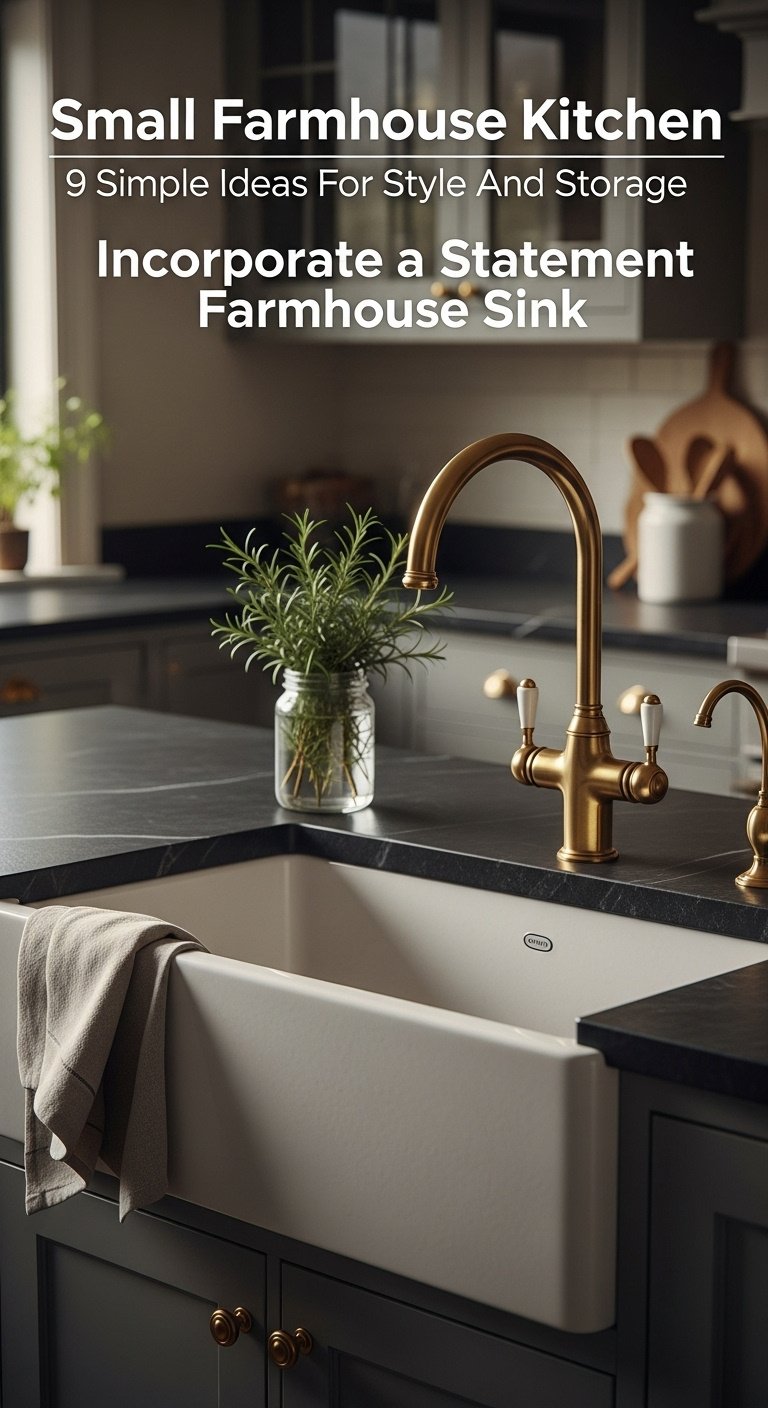
- Materials Needed: (This is a professional job, but for selection criteria): Measuring tape, cabinet specifications.
- Step-by-Step Directions:
- Measure Your Cabinet: The most critical step. Measure the width of your sink base cabinet. You’ll need a sink that is 2-3 inches smaller than this cabinet to fit. Common small sizes are 24″ or 27″.
- Choose a Single Basin: In a small kitchen, a large, deep single basin is more functional than a double basin for washing large pots and pans.
- Select the Material: Classic white fireclay is the quintessential farmhouse choice and is very durable. Cast iron is another heavy-duty option, while stainless steel offers a modern farmhouse twist.
- Pair with a High-Arc Faucet: A gooseneck or bridge faucet not only complements the style but also provides ample clearance for filling and washing large items in the deep sink.
Pro-Tip: An apron-front sink requires a special sink base cabinet with a shorter front panel. If you’re retrofitting, consult a cabinet maker or experienced contractor to modify your existing cabinet correctly. It’s not a simple drop-in replacement.
Dreaming of a farmhouse sink? Share this with someone who needs to see it!
4. Maximize Vertical Storage
The key to an uncluttered small kitchen is to utilize your wall space effectively for vertical storage. Getting items up off the countertops is crucial. Simple solutions like a wooden Shaker-style peg rail for mugs and aprons, a magnetic knife strip to eliminate a bulky block, or a hanging pot rack can free up immense amounts of cabinet and counter space while adding rustic charm.
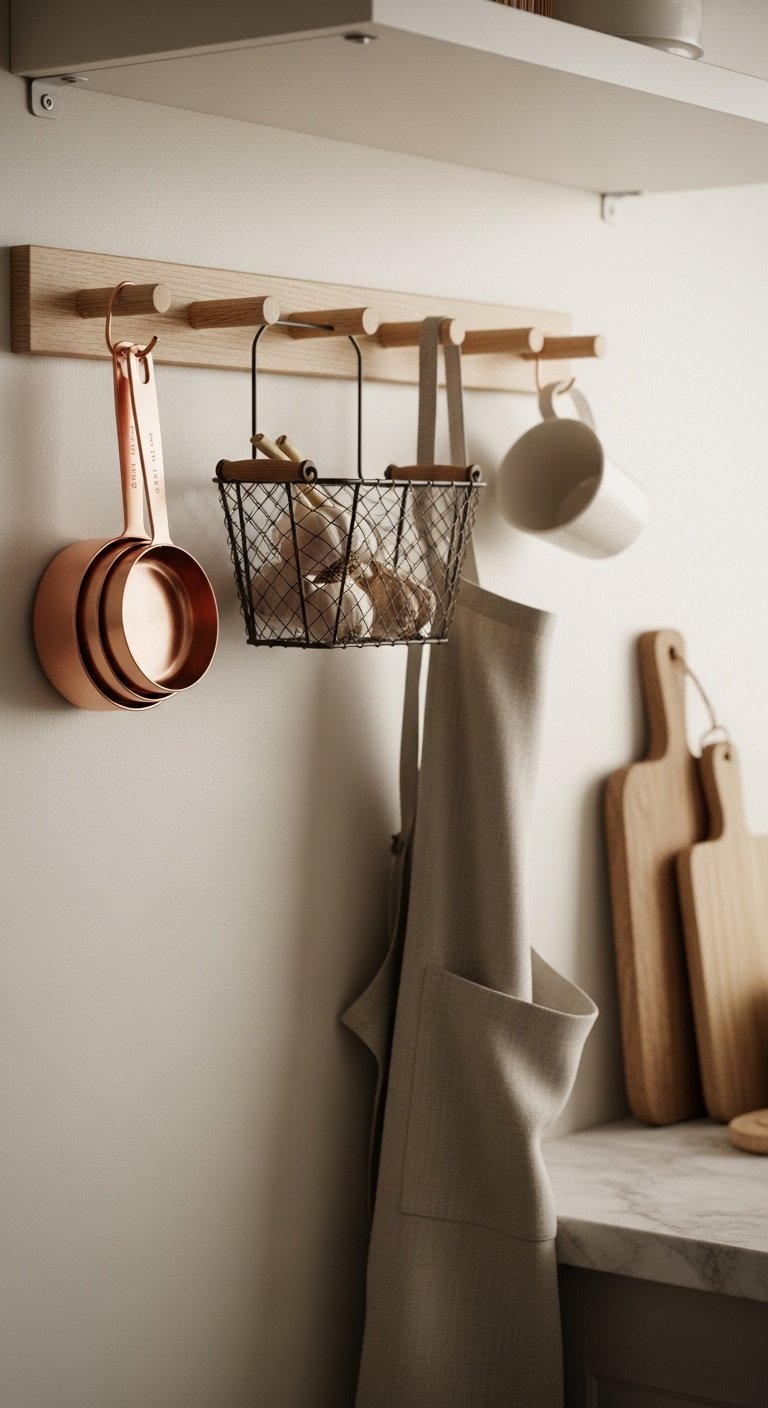
- Materials Needed: A wooden peg rail kit, a drill, a level, wall anchors, measuring tape.
- Step-by-Step Directions:
- Choose Your Wall: Identify a clear stretch of wall, perhaps above a counter or next to a doorway.
- Measure and Mark: Hold the peg rail against the wall and use a level to ensure it’s straight. Mark the screw holes with a pencil.
- Drill and Anchor: Drill pilot holes on your marks. If not hitting a stud, insert wall anchors to ensure the rail is secure enough to hold weight.
- Attach the Rail: Screw the peg rail firmly into the wall.
- Hang Your Items: Use the pegs to hang mugs, small cutting boards, utensils in a basket, aprons, and even fresh herbs.
Pro-Tip: A magnetic knife strip is one of the best vertical storage tipss. It gets that bulky knife block off your precious counter space and keeps your most-used tools within easy reach.
Click here to save this brilliant storage tips for later!
5. Choose Compact and Multi-functional Appliances
In a small kitchen, selecting appropriately scaled and multi-functional appliances is essential to preserve space. Look for “apartment-sized” or “counter-depth” refrigerators and ranges that have a smaller footprint. Furthermore, choose gadgets that serve multiple purposes, like an over-the-range microwave that also functions as a range hood, to prevent single-use items from cluttering your valuable counter real estate.

- Materials Needed: Measuring tape, list of kitchen needs, online marketplaces for refurbished goods.
- Step-by-Step Directions:
- Audit Your Needs: Before buying, make a list of what you actually use. Avoid trendy gadgets that will become clutter. Prioritize essentials.
- Measure Everything: Measure the spaces for your refrigerator, stove, and dishwasher carefully. Look for “apartment-sized” or “counter-depth” models that have a smaller footprint.
- Combine Functions: Opt for an over-the-range microwave that doubles as a range hood to save valuable counter space. Consider a toaster oven that can also air fry or bake.
- Shop Refurbished: For iconic but bulky items like a stand mixer, look for certified refurbished models. They are often cheaper and just as reliable, making the investment worthwhile.
Pro-Tip: When shopping for a refrigerator, pay close attention to the “door swing clearance.” In a tight galley kitchen, a French door or bottom-freezer model often works better than a single-door model that requires a wide swing path.
Pin this for inspiration on your next appliance hunt!
6. Integrate Vintage and Thrifty Accents
The most authentic farmhouse character comes from incorporating unique vintage and thrifted items that are both decorative and functional. Scour flea markets and antique shops for pieces with history and patina. Stoneware crocks to hold utensils, wire baskets for produce, or a collection of old wooden cutting boards add a “collected-over-time” charm that new items simply can’t replicate, all while serving a practical purpose.
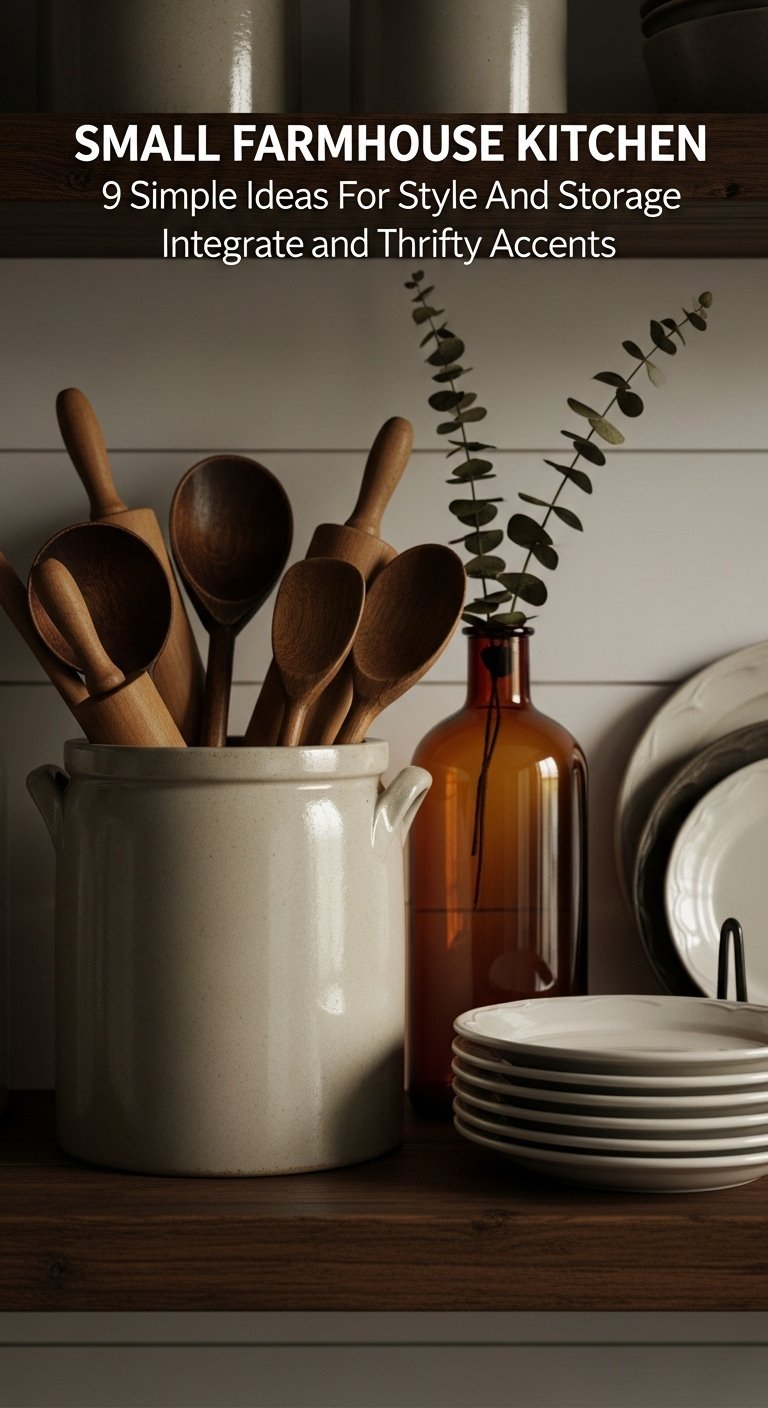
- Materials Needed: A list of desired items (e.g., ironstone pitchers, wooden bowls, baskets), cash, and a vehicle for a trip to local thrift stores or flea markets.
- Step-by-Step Directions:
- Make a “Hunt” List: Go in with a plan. Look for specific items that are both decorative and functional: stoneware crocks to hold utensils, wire baskets for produce, glass canisters for dry goods, or unique art.
- Focus on Texture and Patina: Don’t worry about perfection. Look for items with a bit of wear and tear, like a slightly worn wooden cutting board or a tarnished silver tray. This “collected-over-time” feel is the essence of farmhouse charm.
- Think Function First: Prioritize items that can pull double duty. A vintage pitcher can be a vase, a small wooden crate can be a spice rack, and a beautiful bowl can hold keys or fruit.
- Clean and Display: Thoroughly clean all your finds. Group similar items together for a stronger visual impact, like a collection of three small crocks on an open shelf.
Pro-Tip: The “smalls” section of an antique mall is a goldmine. Look for things like old rolling pins, vintage graters, and unique cookie cutters that can be displayed in a crock on the counter for instant, inexpensive character.
What’s your best thrift store find? Share in the comments!
7. Consider a Mobile Island or Compact Furniture
To add flexible counter space and storage, introduce a mobile kitchen island or a compact cart on wheels. Unlike a permanent, bulky island that can obstruct workflow in a tight space, a rolling cart provides a valuable prep surface and extra shelving that can be easily moved out of the way when needed. This adaptability is key to maintaining an open and functional layout.

- Materials Needed: A rolling kitchen cart or a small, sturdy table; optional heavy-duty locking casters; a drill.
- Step-by-Step Directions:
- Assess Your Floor Space: Use painter’s tape on the floor to outline the maximum footprint a mobile island could occupy without disrupting workflow. Remember to account for door swings.
- Shop for a Cart: Look for a kitchen cart or a small stainless steel restaurant prep table. Prioritize models with at least one shelf for storage and a durable top (butcher block is ideal).
- Add Locking Wheels: If your chosen piece doesn’t have wheels, you can add them. Purchase a set of heavy-duty locking casters and attach them securely to the bottom of the legs. The locking feature is crucial for safety during food prep.
- Utilize It: Use the top for extra prep space, the shelf for storing pots or small appliances, and roll it out of the way when you need more floor space.
Pro-Tip: A small, round pedestal table can be a brilliant multi-tasker. It serves as a dining spot, but its shape allows for better traffic flow in a tight space compared to a a square table. It can also easily double as extra prep space.
Save this flexible kitchen solution to your ‘Small Space Living’ board!
8. Strategic Lighting Choices
The right lighting can dramatically impact the perceived size and ambiance of a small kitchen. Instead of a single, harsh overhead light, layer your lighting. A simple, vintage-inspired pendant light over the sink provides crucial task lighting and acts as a stylish focal point. Ensure you also have good ambient light to illuminate the entire room, which prevents dark corners that make a space feel smaller.
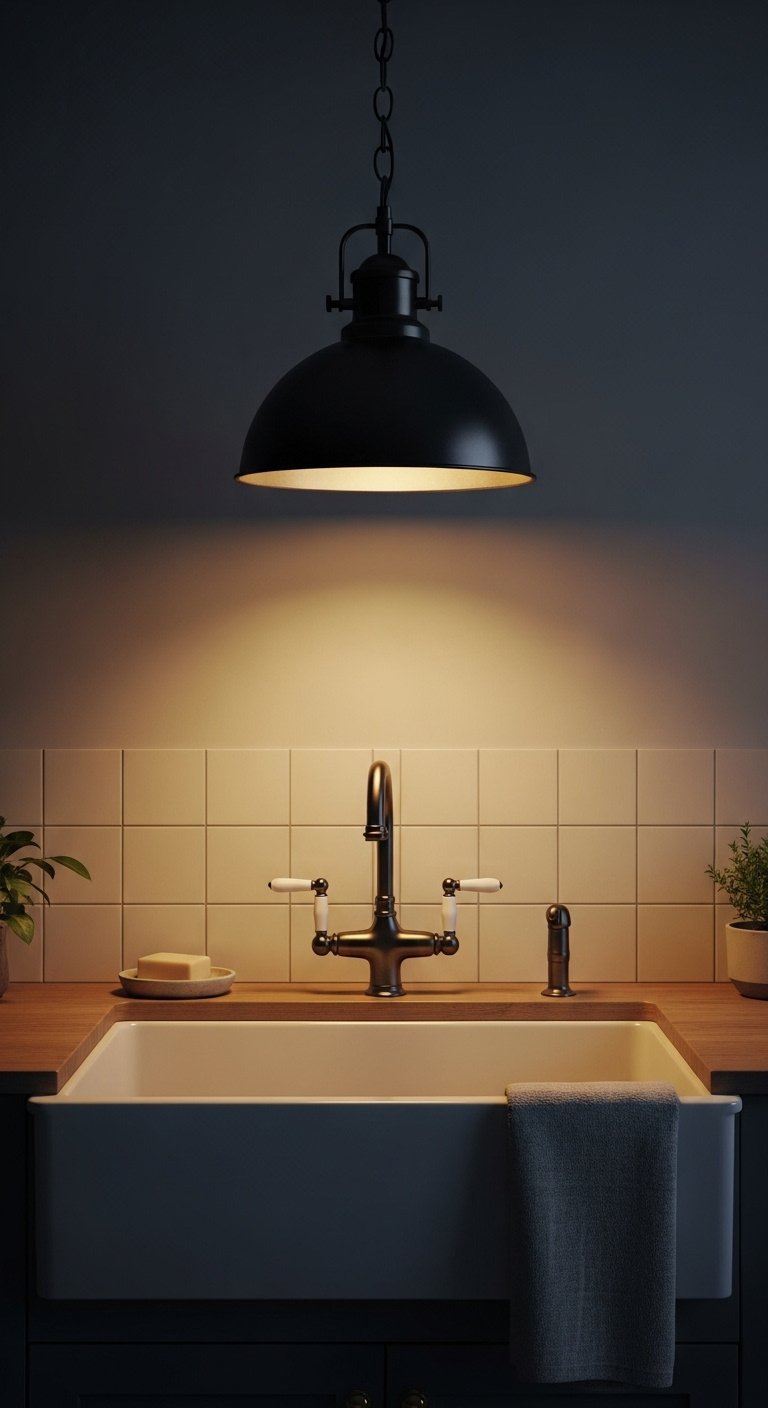
- Materials Needed: Pendant light fixture, wire strippers, screwdriver, voltage tester, (recommend professional installation).
- Step-by-Step Directions:
- Identify Key Zones: Determine where you need focused “task” lighting. The two most important spots in a small kitchen are over the sink and over your primary prep area (which might be a small island or section of counter).
- Choose a Pendant: Select a simple, visually lightweight pendant light. A metal dome, a clear glass shade, or a wire cage design works well. Avoid anything too large or ornate that will visually shrink the space.
- Consider Scale: For a single pendant over a sink, choose a fixture that is about 12-16 inches in diameter. Hang it so the bottom is at least 30-36 inches above the countertop.
- Add Ambient Light: Ensure your main ceiling light is bright enough to illuminate the whole space. A simple, flush-mount fixture with a classic design can replace an outdated one.
Pro-Tip: Install a dimmer switch for your main kitchen lights. This allows you to have bright light for cooking and cleaning, and a soft, ambient glow for a cozy, relaxing atmosphere in the evenings. It’s an inexpensive upgrade with a huge impact.
Light up your life! Pin this simple lighting upgrade idea.
9. Incorporate Decorative Details and Textures
The final layer of farmhouse charm comes from thoughtfully adding textures and textiles. A simple beadboard or shiplap backsplash introduces linear detail and rustic character. Soften hard surfaces with a durable runner rug in a classic gingham or stripe, and add a simple cafe curtain to the window for a touch of charm that doesn’t block precious natural light. These finishing touches make the space feel complete and inviting.
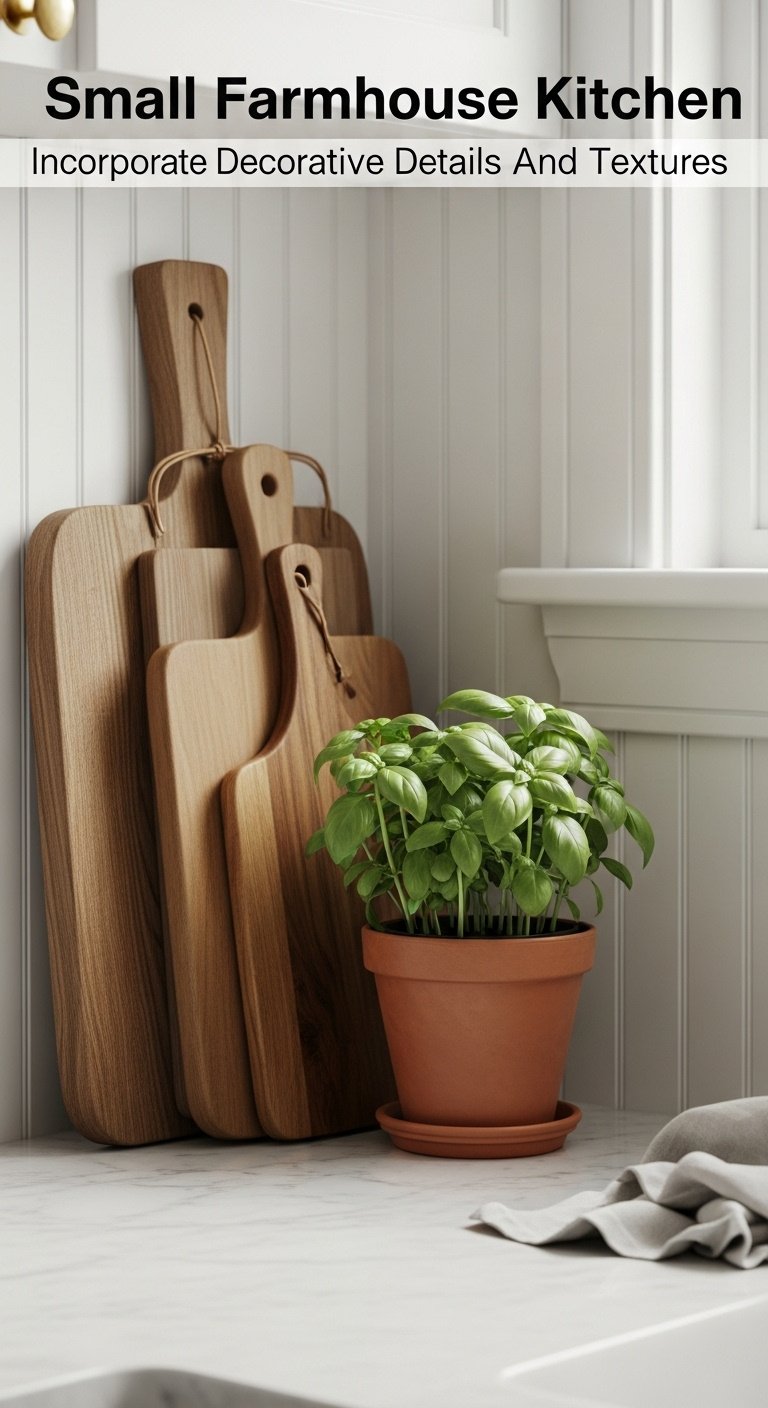
- Materials Needed: A small, washable kitchen runner rug, a tension rod, cafe curtains.
- Step-by-Step Directions:
- Soften the Floor: Choose a durable, washable runner in a simple pattern like stripes or gingham. Place it in front of the sink and main prep area to add color, texture, and comfort underfoot.
- Dress the Window: Forgo heavy drapes. Install a simple cafe curtain on a tension rod over the bottom half of your kitchen window. This adds privacy and charm while still letting in plenty of natural light.
- Display Functional Decor: Don’t hide your pretty and practical items. Lean a collection of wooden cutting boards against the backsplash. Place fresh herbs in a pot on the windowsill. Put wooden spoons in a vintage crock on the counter. These everyday items add warmth and texture.
Pro-Tip: A “faux” shiplap or beadboard backsplash is an easy, budget-friendly DIY project. You can buy panels of beadboard wallpaper or thin plywood planks (often called “luan”) that you can cut, paint white, and nail to the wall for a high-impact textural effect.
What small detail makes your kitchen feel like home? Let us know below!
Key Takeaways: Your Quick Guide to a Small Farmhouse Kitchen
- Go Light & Bright: Use warm whites and soft grays on walls and cabinets to make the space feel larger and more open.
- Think Vertically: Get items off the counter by using open shelving, peg rails, and magnetic knife strips to maximize wall space.
- Choose Smart Furniture: Opt for a mobile kitchen island or a compact, round table instead of bulky, permanent fixtures to maintain flexibility.
- Function is Charm: Use everyday items like wooden cutting boards, vintage crocks, and fresh herbs as your primary decor.
- Invest in a Focal Point: A classic apron-front sink or a stylish pendant light can anchor the design and add major character.
People Also Ask About Small Farmhouse Kitchens
Can you remodel a small kitchen for $5000?
Yes, you absolutely can. A $5,000 budget for a small kitchen requires smart, strategic choices. Focus on high-impact, low-cost updates like painting existing cabinets, upgrading hardware, installing a new backsplash yourself, and choosing a budget-friendly countertop like butcher block. By combining DIY labor with savvy shopping for fixtures and appliances, a stunning transformation is achievable.
What trend is replacing farmhouses?
While classic farmhouse remains popular, trends are shifting towards styles like “Cottagecore,” which is a more romantic, whimsical version with floral patterns and vintage pieces. Additionally, “Modern Rustic” and “Warm Minimalism” are gaining traction. These styles keep the natural wood tones and cozy textures of farmhouse but with cleaner lines, fewer decorative accessories, and a more streamlined feel.
Is farmhouse decor still in style in 2025?
Yes, farmhouse decor is evolving rather than disappearing in 2025. The “cliche” farmhouse look with excessive signs and faux-distressed items is fading, but the core principles—natural materials, cozy textures, and a blend of old and new—remain timeless. The current trend is a more refined “Modern Farmhouse,” focusing on authenticity, clean lines, and a less cluttered, more personal aesthetic.
Final Thoughts
Creating a small farmhouse kitchen is all about making thoughtful choices that reflect your personal style. It proves that you don’t need a huge space to create a warm, inviting, and beautiful heart of the home.
Which of these ideas are you most excited to try in your own kitchen?
